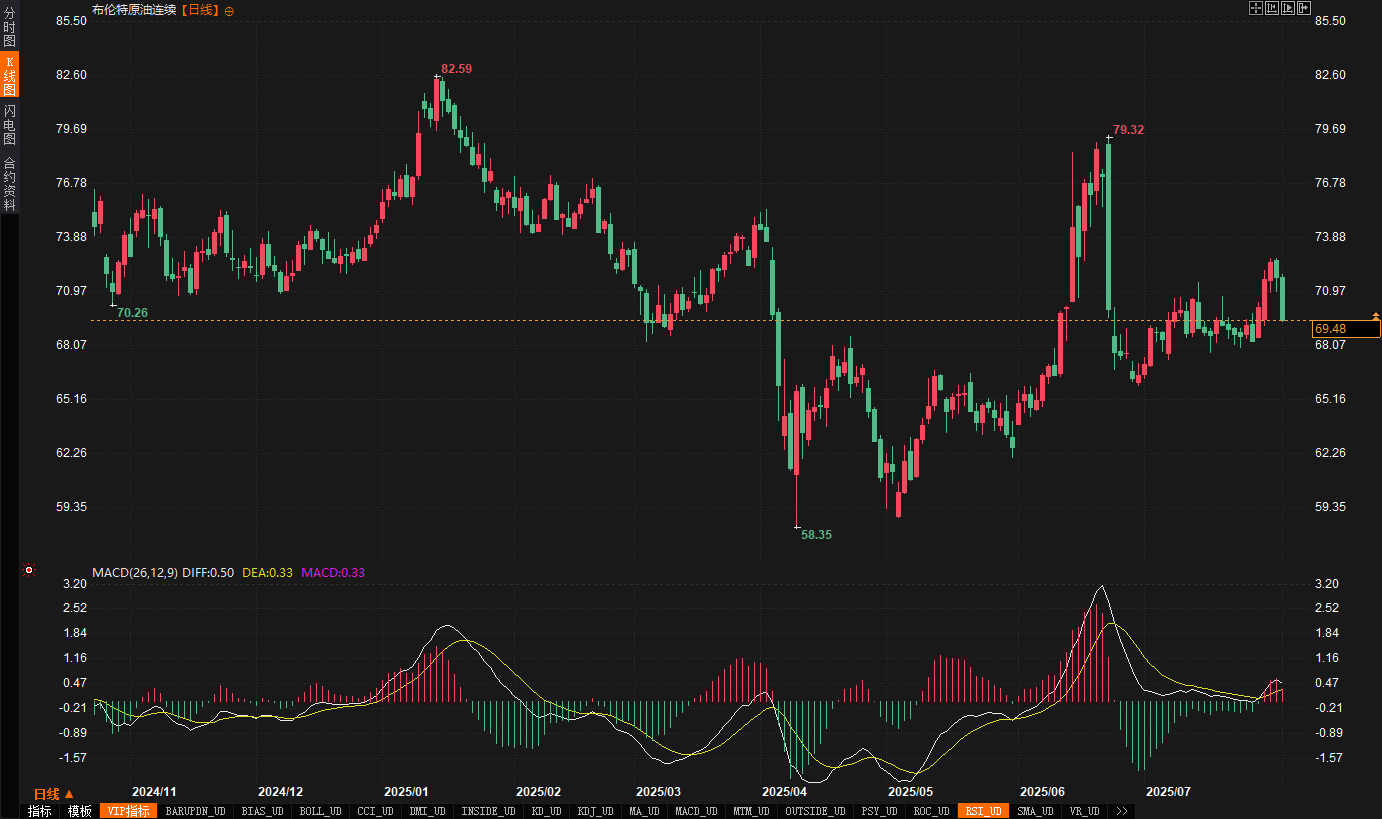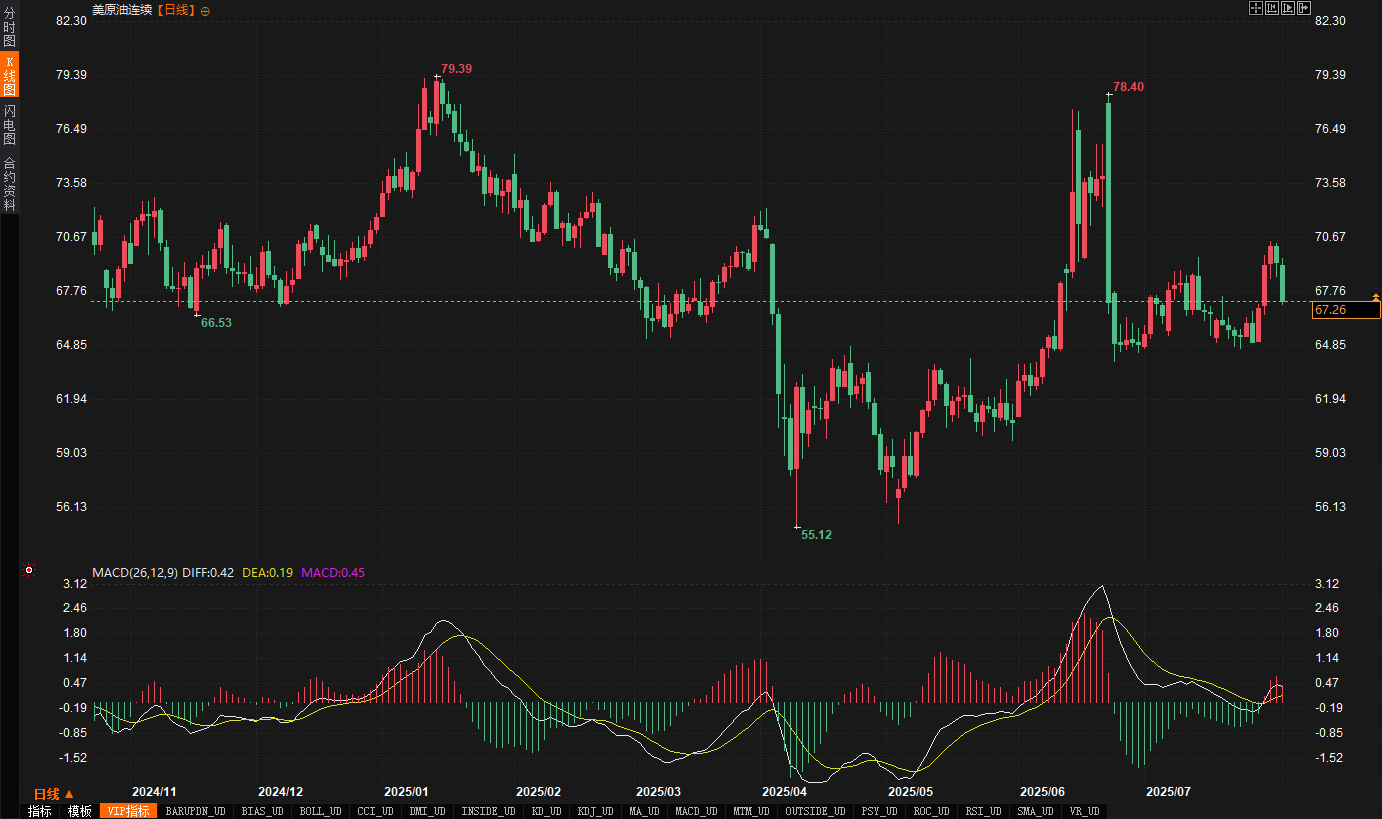Crude oil prices plummeted after a 6% weekly surge! OPEC+ production increases are sniping bulls, and the oil market faces a "triple trial" next week.
2025-08-02 18:35:34

Crude oil market trends this week
This week, the international crude oil market saw a period of initial gains followed by declines. At the beginning of the week, Brent crude and WTI prices saw steady gains, supported by risk aversion triggered by Trump's tariffs. Brent crude climbed from around $67 per barrel on Monday to above $71 on Thursday, while WTI rose from around $65 to the $69 range, reaching their highest points of the week. Friday's US July non-farm payroll data unexpectedly disappointed, with only 73,000 new jobs added, far below market expectations of 110,000, and the unemployment rate rising from 4.1% to 4.2%, raising concerns about an economic slowdown and the outlook for crude oil demand. Meanwhile, sources revealed that OPEC+ may increase production by 548,000 barrels per day in September, further dampening market sentiment. Ultimately, Brent crude closed down $2.03 (2.83%) at $69.67 per barrel on Friday, while WTI fell $1.93 (2.79%) to $67.33 per barrel. Despite the sharp decline on Friday, Brent and WTI still rose by about 6% and 6.29% respectively this week, showing that bullish momentum remains.


Economic data and events
1. July U.S. non-farm payroll data: The U.S. Department of Labor announced on Friday that July's job creation totaled just 73,000, well below market expectations of 110,000. June's data was revised downward to 14,000, and the unemployment rate rose to 4.2%. The weak data heightened market concerns about a U.S. economic slowdown and dampened expectations for crude oil demand.
2. Federal Reserve Interest Rate Decision: On Wednesday, the Fed held its benchmark interest rate steady. Chairman Powell emphasized the "solid" labor market and expressed caution about a September rate cut. This decision drew strong criticism from Trump and Republican lawmakers, who argued that the Fed misjudged the economic situation. Weak non-farm payroll data rekindled market bets on a September rate cut, adding to downward pressure on oil prices.
3. OPEC+ production increase expectations: Three sources familiar with the matter revealed that OPEC+ members are discussing a September production increase plan, which could raise output by 548,000 barrels per day (bpd). Another source said the final increase may be smaller. The production increase expectations directly led to a sharp drop in oil prices on Friday.
4. Trump's Tariff Policy: Trump signed an executive order on Thursday imposing tariffs ranging from 10% to 41% on a wide range of goods from countries (such as Canada and India) that fail to reach trade agreements by the August 1 deadline. Market concerns are that high tariffs will drive up inflation and dampen global economic activity, thereby impacting crude oil demand.
5. Threats related to the Russia-Ukraine conflict: Trump threatened to impose 100% "secondary tariffs" on countries that purchase Russian crude oil, such as India, in an effort to de-escalate the conflict. This move sparked market concerns about restrictions on Russia's 2.75 million barrels per day (bpd) of seaborne oil exports, supporting oil price increases earlier this week.
6. Trade agreements between the United States, Japan, the European Union, and others: The United States has reached trade agreements with the European Union, South Korea, Japan, and the United Kingdom, with relatively low tariff rates (10%-15%). This has partially alleviated market concerns about global trade tensions and boosted confidence in oil prices.
Analyst and Institutional Views
Phil Flynn, senior analyst at Price Futures Group, said Friday's drop in oil prices can be attributed to Trump's tariff policy and the Federal Reserve's decision to maintain high interest rates. Weak non-farm payroll data suggests a slowdown in the US economy, and the Fed's interest rate decision on Wednesday may have misjudged the economic situation. This puts short-term pressure on oil prices, but supply concerns will continue to support prices in the long term.
Suvro Sarkar, an analyst at DBS Bank, believes that this week's oil price increase was primarily driven by market optimism about the US reaching an agreement with its major trading partners. Any progress in future US-China trade negotiations will further boost oil market confidence and push up oil prices.
JPMorgan analysts pointed out that Trump's threat to impose a 100% secondary tariff on Russian crude oil buyers could put Russia's 2.75 million barrels per day (bpd) of seaborne oil exports at risk, especially if major consuming countries are affected. In the short term, concerns about supply disruptions will provide support for oil prices, but caution should be exercised regarding demand-side pressures.
Analysts at one institution stated that uncertainty surrounding OPEC+'s production increase plan was a key factor in Friday's sharp drop in oil prices. If the production increase exceeds expectations, oil prices could fall further; however, if the increase is smaller, the market may quickly absorb the negative impact, leading to a potential rebound in oil prices.
A market analyst pointed out that the market risk aversion caused by the Russia-Ukraine conflict and Trump's tariff threats provided support for oil prices this week, but the weak performance of non-farm payroll data and OPEC+'s production increase expectations have changed market sentiment, and oil prices may fluctuate in the short term.
Market outlook for next week
Next week, the crude oil market will be driven by multiple factors, and traders need to pay close attention to the following key events:
1. OPEC+ production increase decision: OPEC+ is expected to reach an agreement on a September production increase on Sunday. The size of the increase (whether it will be 548,000 barrels per day or lower) will be a key driver of oil prices. If the increase is small, the market will likely absorb the negative impact, and oil prices are expected to stabilize or even rebound. However, if the increase exceeds expectations, oil prices may come under further pressure.
2. US Economic Data: July's ISM non-manufacturing PMI and June's factory orders data will provide fresh clues to US economic activity. If the data continue to indicate an economic slowdown, market concerns about crude oil demand could intensify, adding downward pressure on oil prices. Conversely, a surprisingly positive data outlook could ease demand concerns and support oil prices.
3. Trump's Tariff Policy: Tariffs on Canada (35%), India (25%), and other countries will officially take effect next Friday. The market will closely assess their actual impact on the global economy and crude oil demand. If Trump further escalates trade tensions, market risk aversion could push up oil prices; if trade tensions ease, oil prices may face downward pressure.
4. Developments related to the Russia-Ukraine conflict: Trump's threat to impose 100% "secondary tariffs" on countries purchasing Russian crude oil, such as India, may fuel market concerns about restrictions on Russia's 2.75 million barrels per day (bpd) of seaborne oil exports. If the threat escalates, oil prices could rise on expectations of supply disruptions; if the situation de-escalates, oil prices could lose some support.
5. Global Market Sentiment: The trade agreements reached this week by the US, Japan, and the EU have partially eased market concerns about global trade tensions, but Trump's tough stance toward countries with which he has not reached an agreement may continue to cause market volatility. Traders should pay attention to the market's reaction to the progress of trade negotiations, especially in terms of trade negotiations.
This week, the crude oil market experienced significant volatility, driven by the combined influence of Trump's tariff policy, supply concerns stemming from the Russia-Ukraine conflict, and weak US economic data. Expectations of an OPEC+ production increase and weak non-farm payroll data led to a sharp drop in oil prices on Friday, but prices still posted significant gains for the week. Next week, OPEC+'s decision to increase production, US economic data, and the subsequent developments of Trump's tariff policy will be key drivers of oil prices. Traders should remain vigilant, closely monitor the latest developments on the supply and demand sides, and flexibly adjust their strategies to address market uncertainties.
- Risk Warning and Disclaimer
- The market involves risk, and trading may not be suitable for all investors. This article is for reference only and does not constitute personal investment advice, nor does it take into account certain users’ specific investment objectives, financial situation, or other needs. Any investment decisions made based on this information are at your own risk.





















